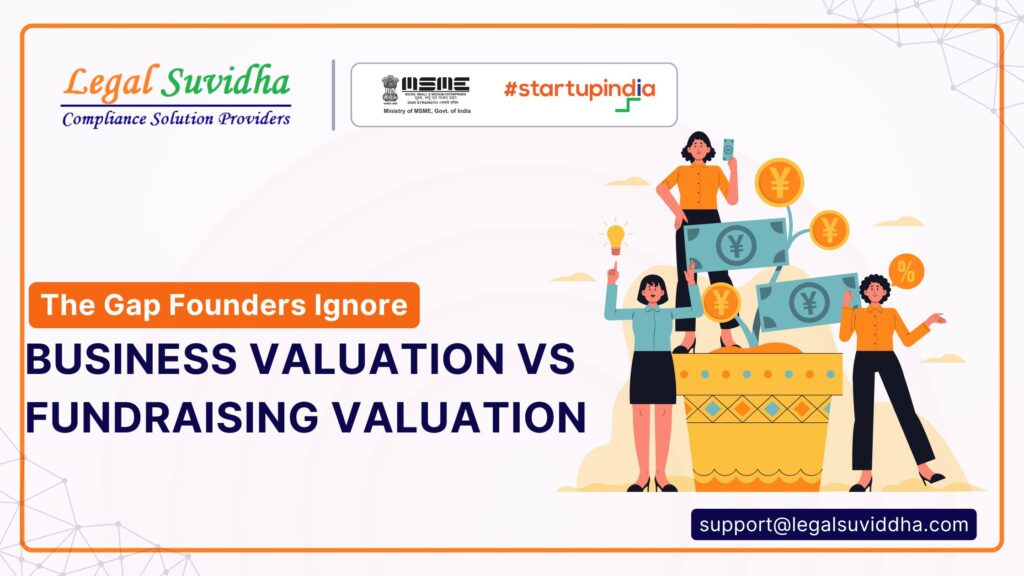Business Valuation vs Fundraising Valuation: The Gap Founders Ignore
A Founder’s Wake-Up Call
We raised $1.2 million at a $5 million valuation!
Rohit, a young startup founder, posted on LinkedIn, overflowing with excitement. The comments poured in: “Wow,” “Incredible,” Killing it, bro!
But what no one saw was the conversation that followed with his co-founder that night:
Wait… didn’t our financial model suggest we were worth $9 million based on revenue projections?
That’s when it hit them. The investor valuation and the business valuation weren’t matching.
They’d celebrated the funding round but silently walked into a dilution trap.
Welcome to the silent gap in the startup world—Business Valuation vs Fundraising Valuation.
What’s Really Causing the Confusion?
Rohit and his co-founder Priya had spent two years building their B2B SaaS product.
They had traction, $20K MRR, and a clear growth roadmap.
Their CA had done a business valuation using DCF and market comps—coming in at ₹75 crore (around $9M).
But during fundraising, the investor offered a term sheet valuing them at ₹40 crore ($5M pre-money).
Caught in the moment—and with the runway shrinking—they said yes.
They gave away 20% of their company when they only needed to give 11%.
They ignored the valuation gap.
Why This Misunderstanding Can Cost You Big
You might think—Isn’t fundraising valuation just what someone is willing to pay?
Yes, but here’s the trap:
Investors value risk, narrative, and negotiation leverage
Founders value growth, market size, and IP
This mismatch leads to:
Over-dilution early on
Down-round risks in later stages
Demotivation when founders lose control faster than they expected
Most early-stage founders do not benchmark their internal valuation with external market expectations.
This startup valuation gap silently eats into equity, morale, and long-term ownership.
How to Get Your Valuation Game Right
So what’s the secret sauce?
✅Use a dual-valuation approach:
One for internal planning (Business Valuation)
One to pitch and negotiate (Fundraising Valuation)
✅ Get a valuation certificate done from a SEBI-registered valuer before your raise.
✅ Prepare a narrative-backed financial model to justify the investor valuation.
When you understand both, you can bridge them with storytelling and term sheet strategy.
It’s not about rejecting low offers—it’s about negotiating from clarity.
This is what successful founders do. They never walk blind into dilution.
Looking at the Bigger Picture A Valuation Strategy That Works
Imagine this:
You walk into an investor meeting with:
A business valuation backed by numbers
A funding valuation anchored in realism
Clauses like valuation caps, SAFE notes, or anti-dilution protections ready
You’re not just pitching. You’re steering the deal.
This is why understanding Business Valuation vs Fundraising Valuation is not just helpful—it’s essential.
Your strategy should involve:
Financial valuation experts
Legal review of terms
Market benchmarking
Rights negotiation
Don’t just raise funds. Raise smart.
What You Can Do Right Now –
Here are your two options:
Option 1: Do Nothing
Keep raising money without understanding how your dilution adds up. Hope it all works out, and deal with regret when your stake is down to single digits.
Option 2: contact with Legal Suvidha
Decode your business valuation
Benchmark your fundraising valuation
Guide your fundraising strategy legally and financially
before you’re left wondering where your equity went. How to Structure Your Founder Salary to Save Maximum Tax
Connect with our Domain Expert or reach out via WhatsApp for instant help.
Phone: 8130645164
Email: [email protected]
Website: www.legalsuvidha.com
SAFE Notes, CCDs, and Equity: Choosing the Right Funding Instrument
Compliance Checklist for Getting Funded


![Received an Income Tax Notice in India? Don’t Panic — Here’s Exactly What to Do [2025 Guide] 1 Income Tax Notice](https://legalsuvidha.com/wp-content/uploads/2025/12/Income-Tax-Notice.png)
![Cyber Crime FIR in India: How to File Complaint for Online Fraud, Banking Fraud & Digital Harassment [2025 Guide] 2 Cyber Crime Complaint](https://legalsuvidha.com/wp-content/uploads/2025/12/Cyber-Crime-Complaint.png)
![Trademark Infringement in India: How to File Legal Action & Protect Your Brand [2025 Guide] 3 Tradenark Infrigement](https://legalsuvidha.com/wp-content/uploads/2025/12/Tradenark-Infrigement.png)
![Property Title Verification in India: How to Check Clear Title in 7 Steps [Avoid Property Fraud – 2025 Guide] 4 Property Titles Verification](https://legalsuvidha.com/wp-content/uploads/2025/12/Property-Titles-Verification.png)



